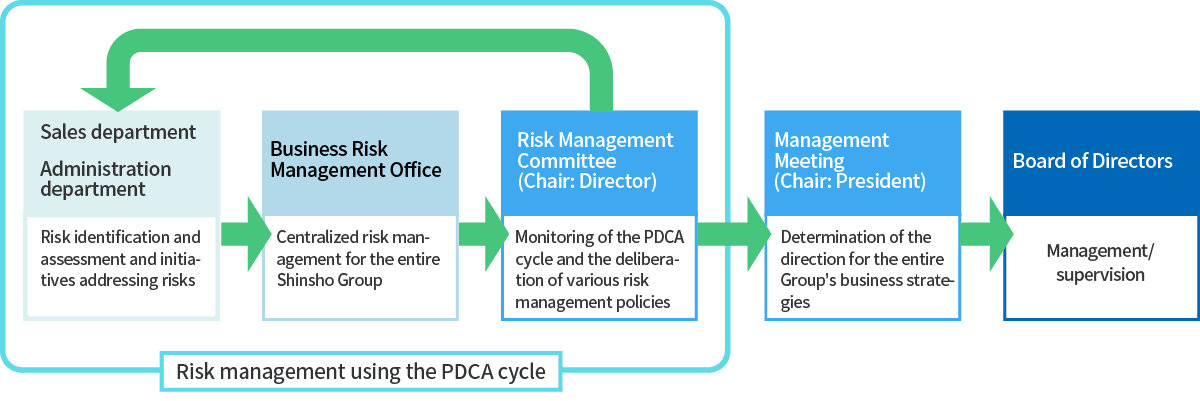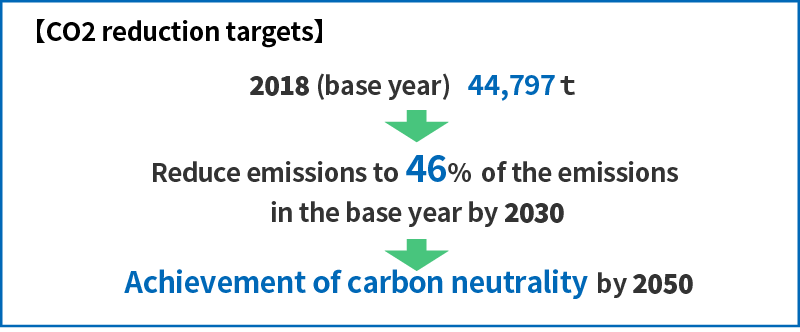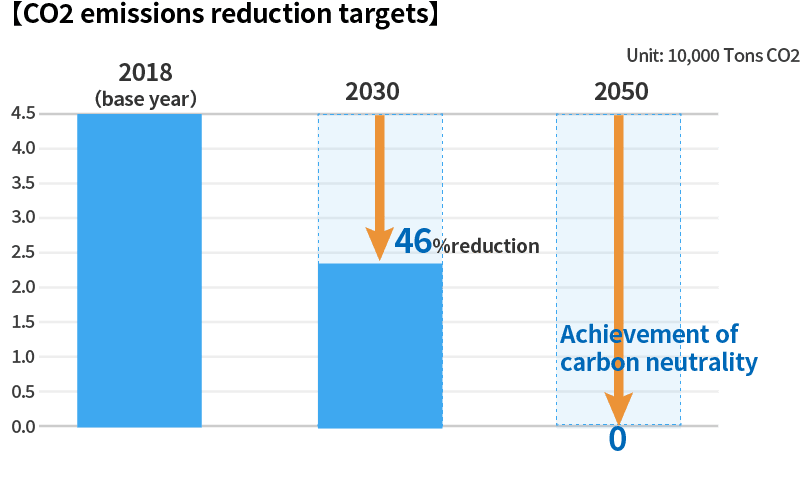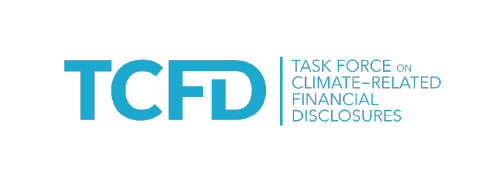On June 7, 2022, the Company endorsed the Task Force on Climate-related Financial Disclosures (TCFD) Recommendations and joined the TCFD Consortium that consists of companies, financial institutions, and other entities supporting the recommendations.
The Corporate Group will contribute to the realization of a sustainable society by setting CO2 emissions reduction targets for the achievement of carbon neutrality in 2050.
1.Basic policy
We understand that actions to address climate change are an important management issue and we work continuously to contribute to society in terms of climate change leveraging our abilities as a trading company, in addition to the reduction of the CO2 emissions of the entire Group.
2.Promotion structure
The Company established the Sustainability Committee headed by the CEO in April 2022.
To address environmental problems including climate change, which is one of the important management issues faced by the Corporate Group, the Committee meets twice a year, deliberates, formulates basic policies, identifies important items, etc., and monitors the progress of initiatives in cooperation with the Risk Management Committee which is mainly in charge of the identification and assessment of risks.
Results are regularly reported to the Board of Directors for the management and supervision of the reported activities.
3.Climate change risks and opportunities
1)Risks
| Category | Risk factors | Impact on business | Measures addressing risk | ||||
|---|---|---|---|---|---|---|---|
| Details | Financial impact | ||||||
| Revenue | Cost of sales | Gross profit | |||||
| Transition risks | Policies and regulations | ● Progress in pricing GHG emissions ● Improved energy-conservation policies |
Rising purchase prices due to progress in the pricing of GHG emissions, including carbon taxes | ー | ⇑ | ⇓ | ● Reduction of the CO2 emissions of supply chains in collaboration with suppliers ● Transition to handling environment-friendly products and equipment ● CTransition to supplying raw materials that supports ironmaking methods with lower CO2 emissions ● Initiatives for the introduction of renewable energy |
| Decrease in the transaction volume of non-energy-saving conventional products | ⇓ | ー | ⇓ | ||||
| Decrease in the transaction volume of coal and other products with the following entities that emit large amounts of CO2 ・Materials manufacturers ・Blast furnace manufacturers ・Power plants |
⇓ | ー | ⇓ | ||||
| Rising purchase prices due to increased costs associated with the energy transition for decarbonization | ー | ⇑ | ⇓ | ||||
| Technology | ● Replacement of existing products/services with low-carbon options ● Upfront expenses associated with the transition to low-carbon technologies |
Decrease in transactions of non-energy-saving conventional products | ⇓ | ー | ⇓ | ● Shift to transactions of environment-friendly materials ● Product development based on new technologies and research into market trends |
|
| Decrease in transactions of steel products due to the transition to EVs and light-weight vehicles | ⇓ | ー | ⇓ | ||||
| ncrease in additional expenses incurred by manufacturing subsidiaries and others for the introduction of new technologies | ー | ⇑ | ⇓ | ||||
| Market | ● Change in consumers’ behavior ● Soaring raw materials costs |
Decrease in transactions of non-energy-saving products and products with high environmental burdens | ⇓ | ー | ⇓ | ● Transition through the promotion of co-firing using biomass fuels and the shift to biomass fuels ● Expansion of sales of steel products for parts other than engines ● Support for research that contributes to the reduction of emissions from entire raw materials value chains |
|
| Decrease in transactions of coal and other fossil fuels due to decreasing demand | ⇓ | ー | ⇓ | ||||
| Decrease in transactions of internal combustion vehicle parts and manufacturing equipment | ⇓ | ー | ⇓ | ||||
2)Opportunities
| Category | Opportunity factor | Impact on business | |||
|---|---|---|---|---|---|
| Details | Financial impact | ||||
| Revenue | Cost of sales | Gross profit | |||
| Products and services | Development and expansion of low-carbon products and services | Increase in transactions of scrap for electric furnaces and fuels for biomass power generation | ⇑ | ー | ⇑ |
| Participation in businesses which include processes whose CO2 emissions can be reduced | ⇑ | ー | ⇑ | ||
| Increase in transactions of environmental-friendly products | ⇑ | ー | ⇑ | ||
| Increase in transactions of recycled raw materials (various scrap, slag, and RPF) | ⇑ | ー | ⇑ | ||
| Increase in demand for copper and aluminum products for use with batteries in association with electrification | ⇑ | ー | ⇑ | ||
| Market | Access to new markets | Increase in transactions of new parts and new materials due to the popularization of EV vehicles, including battery materials for EVs, magnets and other motor-related devices, and secondary materials | ⇑ | ー | ⇑ |
| Increase in transactions of environment-friendly, energy-saving and highly efficient machinery and equipment | ⇑ | ー | ⇑ | ||
4.Risk management
Regarding climate-related risks, which we believe affect the business continuity of the entire Corporate Group, the PDCA cycle is followed for the identification, assessment, and creation of initiatives to address risks based on the risk action plans prepared by each division. The status of operations is centrally managed by the Business Risk Management Office.
In addition, the Risk Management Committee monitors the PDCA cycle, discusses an array of measures and policies for the appropriate management of risk, and submits its results to the Management Council which determines the direction for management such as business strategies, for deliberation to enhance the risk management system of the entire Corporate Group.
The Management Council reports the issues that it determines to be important regarding management strategies to the Board of Directors.


5.Metrics and targets
● Initiatives to reduce CO2 emissions
For the initiatives being taken by the Corporate Group to reduce CO2 emissions, we have set the following long-term targets based on the CO2 emissions in FY2018 (scope 1 and 2) and have decided to promote the introduction of green energy.


*Going forward, we will consider the disclosure of the supply chain emissions (scope 3).
6.Main initiatives for reducing emissions
(1) Use of renewable energy
Transition to purchasing electricity from renewable energy sources
Promote the introduction of the self-consumption model of electricity, including solar power generation
(2) Reduction of power consumption
Promote the introduction of highly efficient energy-saving equipment
Reducing electricity consumption and thorough conformance with Cool Biz
Promote work style reforms (telecommuting, remote conferences, etc.)
(3) Encouraging the shift to alternative fuels
Shift from oil and coal to LNG, etc., and shift to EVs
* Scope 1: Greenhouse effect gas emitted directly from the reporting company itself (fuel combustion)
Scope 2: Greenhouse effect gas emitted indirectly from the use of electricity, heat, and steam, which are supplied from other companies
Scope 3: Greenhouse effect gas emitted indirectly, which does not fall under Scopes 1 and 2 (emission from other companies associated with the activities of the reporting company)








